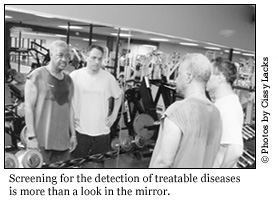PSA Study Spring 2002 – Prostate Cancer – Urological Research Foundation

“How few things can be demonstrated!…Who has proved that tomorrow will dawn, and that we will die? And what is more widely believed?” (Pascal’s Pensees)
The value of routine screening for prostate cancer has been a recent topic of several articles in prominent newspapers.
Some of these articles imply that the screening tests can be as dangerous as the cancers they detect. Screening for prostate cancer is controversial, but it shouldn’t be.
Opponents say that prostate cancer screening should not be recommended until there is absolute proof that it does more good than harm. Also, they believe that we should not spend precious health-care dollars on prostate cancer screening until we are sure that it is worthwhile.
Until we have the results from valid clinical trials, it is difficult to prove that screening for prostate cancer is beneficial but easy to show that screening and treatment can have side effects.
Nevertheless, screening is crucial for good outcomes in prostate cancer because the disease usually does not cause symptoms until it is too late for a cure. Screening is important because it identifies individuals who are at high risk for having a dangerous form of the disease.
Most often, advocates of screening are actively involved in the management of prostate cancer patients and they recommend screening because they have seen that it works. Their perspective is that with no means of preventing prostate cancer and no cure for advanced disease, the only practical strategy for reducing death rates is to detect prostate cancer early and treat it effectively.
The American Cancer Society and the American Urological Association recommend that men aged 50 years and older with at least 10 years life expectancy should be offered prostate cancer screening each year. High-risk men, such as African-Americans and those with a family history of prostate cancer, should be offered screening at an earlier age.
Screening for prostate cancer involves the PSA blood test and the digital rectal examination. The PSA test is one of the most accurate cancer screening tests in medicine. It is not painful or dangerous.
Current evidence suggests that the PSA test has been a valuable tool in detecting life-threatening cancer in many thousands of men. An elevated PSA level indicates a problem in the prostate gland benign enlargement, inflammation, cancer, or a combination of these conditions. The PSA test provides an accurate assessment of the chances that prostate cancer will be found if a biopsy is performed.
False positive PSA tests occur in about 6% of all men tested, including two-thirds with levels higher than 4 ng/ml. But false positive tests can be reduced by 20 percent through the use of the free PSA test — another valuable test that helps to pinpoint the faster growing tumors.
Using a lower PSA cutoff to recommend a biopsy (2.5 ng/ml) also can reduce false negative tests. Prostate biopsies can be performed with little pain under local anesthesia and with a serious complication rate of less than 1%.
Approximately 16% of men will be diagnosed with prostate cancer during their lifetime. Prostate cancer is the second-leading cause of death from cancer in the US. PSA testing does not detect many so-called harmless cancers. Rather, it detects potentially dangerous cancers that have a high likelihood of affecting the patient’s life.
Experienced doctors are able to recognize dangerous prostate cancers by the PSA level, biopsy findings, and rectal examination findings. Although there is controversy about which treatments are most effective; surgery, radiation, and hormonal therapy all are effective in reducing suffering and death from prostate cancer.
Contrary to what is suggested in some articles, PSA testing is not harmful. Widespread PSA screening began in the early 1990s in the US, after a 30 year period of steadily rising prostate cancer death rates. The PSA test is performing as other valuable screening tests have previously performed in the early years of their use It detects prostate cancer much earlier than previously possible, providing about 5 years lead-time.
The percentage of incurable cancers has greatly decreased, and the death rates from prostate cancer have declined by nearly 5% per year since 1995. Recent publications from the National Cancer Institute have ascribed this decline in part to PSA screening. From an economic standpoint, the financial costs of treating advance prostate cancer are much greater than those of treating early disease.
Pending completion of clinical trials, the evidence for the benefits of PSA testing grows stronger each year. If widespread PSA testing continues, I predict we will see a fall in the death rates from prostate cancer that are similar to those that occurred with cervical cancer following the widespread use of pap smears.
I believe a balanced assessment of the evidence now strongly suggests that in appropriately selected men, screening will allow curative treatment of silent prostate cancers that otherwise would cause death and disability.







